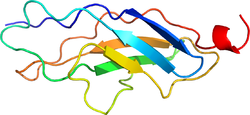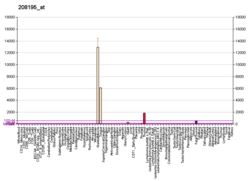Titin: Difference between revisions
no need for a "see also" section that only lists articles already mentioned in the article body |
replaced protein box with User:ProteinBoxBot |
||
| Line 9: | Line 9: | ||
{{Distinguish|Tintin}} |
{{Distinguish|Tintin}} |
||
| ⚫ | |||
{{Protein |
|||
|Name={{PAGENAME}} |
|||
<!-- The PBB_Controls template provides controls for Protein Box Bot, please see Template:PBB_Controls for details. --> |
|||
|Symbol=TTN |
|||
{{PBB_Controls |
|||
|AltSymbols= |
|||
| update_page = yes |
|||
|HGNCid=12403 |
|||
| require_manual_inspection = no |
|||
|Chromosome=2 |
|||
| update_protein_box = yes |
|||
|Arm=q |
|||
| update_summary = no |
|||
|Band=31 |
|||
| update_citations = yes |
|||
|LocusSupplementaryData= |
|||
| ⚫ | |||
| ⚫ | |||
|EntrezGene=7273 |
|||
|RefSeq=NM_133378 |
|||
| ⚫ | |||
|image=SlidingMyofibril.svg |
|||
| ⚫ | |||
}} |
}} |
||
<!-- The GNF_Protein_box is automatically maintained by Protein Box Bot. See Template:PBB_Controls to Stop updates. --> |
|||
{{GNF_Protein_box |
|||
| image = PBB_Protein_TTN_image.jpg |
|||
| image_source = [[Protein_Data_Bank|PDB]] rendering based on 1bpv. |
|||
| PDB = {{PDB2|1bpv}}, {{PDB2|1g1c}}, {{PDB2|1h8b}}, {{PDB2|1nct}}, {{PDB2|1ncu}}, {{PDB2|1tit}}, {{PDB2|1tiu}}, {{PDB2|1tki}}, {{PDB2|1tnm}}, {{PDB2|1tnn}}, {{PDB2|1waa}}, {{PDB2|1ya5}}, {{PDB2|2a38}}, {{PDB2|2bk8}}, {{PDB2|2f8v}}, {{PDB2|2ill}}, {{PDB2|2nzi}} |
|||
| Name = Titin |
|||
| HGNCid = 12403 |
|||
| Symbol = TTN |
|||
| AltSymbols =; CMD1G; CMH9; CMPD4; DKFZp451N061; FLJ26020; FLJ26409; FLJ32040; FLJ34413; FLJ39564; FLJ43066; HMERF; LGMD2J; TMD |
|||
| ⚫ | |||
| ⚫ | |||
| Homologene = 26418 |
|||
| MGIid = 98864 |
|||
| GeneAtlas_image1 = PBB_GE_TTN_208195_at_tn.png |
|||
| Function = {{GNF_GO|id=GO:0000166 |text = nucleotide binding}} {{GNF_GO|id=GO:0004601 |text = peroxidase activity}} {{GNF_GO|id=GO:0004674 |text = protein serine/threonine kinase activity}} {{GNF_GO|id=GO:0004713 |text = protein-tyrosine kinase activity}} {{GNF_GO|id=GO:0004872 |text = receptor activity}} {{GNF_GO|id=GO:0005199 |text = structural constituent of cell wall}} {{GNF_GO|id=GO:0005516 |text = calmodulin binding}} {{GNF_GO|id=GO:0005524 |text = ATP binding}} {{GNF_GO|id=GO:0008307 |text = structural constituent of muscle}} {{GNF_GO|id=GO:0016740 |text = transferase activity}} {{GNF_GO|id=GO:0017022 |text = myosin binding}} {{GNF_GO|id=GO:0042802 |text = identical protein binding}} {{GNF_GO|id=GO:0051393 |text = alpha-actinin binding}} |
|||
| Component = {{GNF_GO|id=GO:0000794 |text = condensed nuclear chromosome}} {{GNF_GO|id=GO:0005634 |text = nucleus}} {{GNF_GO|id=GO:0016020 |text = membrane}} {{GNF_GO|id=GO:0030018 |text = Z disc}} |
|||
| Process = {{GNF_GO|id=GO:0005975 |text = carbohydrate metabolic process}} {{GNF_GO|id=GO:0006468 |text = protein amino acid phosphorylation}} {{GNF_GO|id=GO:0006941 |text = striated muscle contraction}} {{GNF_GO|id=GO:0006979 |text = response to oxidative stress}} {{GNF_GO|id=GO:0007067 |text = mitosis}} {{GNF_GO|id=GO:0030239 |text = myofibril assembly}} {{GNF_GO|id=GO:0046777 |text = protein amino acid autophosphorylation}} |
|||
| Orthologs = {{GNF_Ortholog_box |
|||
| Hs_EntrezGene = 7273 |
|||
| Hs_Ensembl = ENSG00000155657 |
|||
| Hs_RefseqProtein = NP_003310 |
|||
| Hs_RefseqmRNA = NM_003319 |
|||
| Hs_GenLoc_db = |
|||
| Hs_GenLoc_chr = 2 |
|||
| Hs_GenLoc_start = 179099985 |
|||
| Hs_GenLoc_end = 179380394 |
|||
| ⚫ | |||
| Mm_EntrezGene = 22138 |
|||
| Mm_Ensembl = ENSMUSG00000051747 |
|||
| Mm_RefseqmRNA = NM_011652 |
|||
| Mm_RefseqProtein = NP_035782 |
|||
| Mm_GenLoc_db = |
|||
| Mm_GenLoc_chr = 2 |
|||
| Mm_GenLoc_start = 76514471 |
|||
| Mm_GenLoc_end = 76641992 |
|||
| Mm_Uniprot = |
|||
}} |
|||
}} |
|||
'''Titin''', also known as '''connectin'''<ref>{{OMIM|188840}}</ref> ([[UniProt]] name: Q10466_HUMAN; [[accession number]]: Q10466), is a [[protein]] that is important in the contraction of [[striated muscle]] tissues. |
'''Titin''', also known as '''connectin'''<ref>{{OMIM|188840}}</ref> ([[UniProt]] name: Q10466_HUMAN; [[accession number]]: Q10466), is a [[protein]] that is important in the contraction of [[striated muscle]] tissues. |
||
| Line 49: | Line 80: | ||
==References== |
==References== |
||
<div class="references-small"><references /></div> |
<div class="references-small"><references /></div> |
||
==Further reading== |
|||
{{refbegin | 2}} |
|||
{{PBB_Further_reading |
|||
| citations = |
|||
*{{cite journal | author=Kinbara K, Sorimachi H, Ishiura S, Suzuki K |title=Skeletal muscle-specific calpain, p49: structure and physiological function. |journal=Biochem. Pharmacol. |volume=56 |issue= 4 |pages= 415-20 |year= 1998 |pmid= 9763216 |doi= }} |
|||
*{{cite journal | author=Kolmerer B, Witt CC, Freiburg A, ''et al.'' |title=The titin cDNA sequence and partial genomic sequences: insights into the molecular genetics, cell biology and physiology of the titin filament system. |journal=Rev. Physiol. Biochem. Pharmacol. |volume=138 |issue= |pages= 19-55 |year= 1999 |pmid= 10396137 |doi= }} |
|||
*{{cite journal | author=Trinick J, Tskhovrebova L |title=Titin: a molecular control freak. |journal=Trends Cell Biol. |volume=9 |issue= 10 |pages= 377-80 |year= 1999 |pmid= 10481174 |doi= }} |
|||
*{{cite journal | author=Sorimachi H, Ono Y, Suzuki K |title=Skeletal muscle-specific calpain, p94, and connectin/titin: their physiological functions and relationship to limb-girdle muscular dystrophy type 2A. |journal=Adv. Exp. Med. Biol. |volume=481 |issue= |pages= 383-95; discussion 395-7 |year= 2000 |pmid= 10987085 |doi= }} |
|||
*{{cite journal | author=Tskhovrebova L, Trinick J |title=Role of titin in vertebrate striated muscle. |journal=Philos. Trans. R. Soc. Lond., B, Biol. Sci. |volume=357 |issue= 1418 |pages= 199-206 |year= 2002 |pmid= 11911777 |doi= 10.1098/rstb.2001.1028 }} |
|||
*{{cite journal | author=Sela BA |title=[Titin: some aspects of the largest protein in the body] |journal=Harefuah |volume=141 |issue= 7 |pages= 631-5, 665 |year= 2002 |pmid= 12187564 |doi= }} |
|||
*{{cite journal | author=Wu Y, Labeit S, Lewinter MM, Granzier H |title=Titin: an endosarcomeric protein that modulates myocardial stiffness in DCM. |journal=J. Card. Fail. |volume=8 |issue= 6 Suppl |pages= S276-86 |year= 2003 |pmid= 12555133 |doi= 10.1054/jcaf.2002.129278 }} |
|||
*{{cite journal | author=Tskhovrebova L, Trinick J |title=Properties of titin immunoglobulin and fibronectin-3 domains. |journal=J. Biol. Chem. |volume=279 |issue= 45 |pages= 46351-4 |year= 2004 |pmid= 15322090 |doi= 10.1074/jbc.R400023200 }} |
|||
}} |
|||
{{refend}} |
|||
==External links== |
==External links== |
||
Revision as of 02:43, 24 February 2008
Titin, also known as connectin[5] (UniProt name: Q10466_HUMAN; accession number: Q10466), is a protein that is important in the contraction of striated muscle tissues.
Structure
Titin is the largest known protein, consisting of 26,926 amino acids. The molecular weight of the mature protein is approximately 2,993,451.39 Da, and it has a theoretical pI of 6.01[6] The protein's empirical chemical formula is C132983H211861N36149O40883S693. It has a theoretical instability index (II) of 39.69, indicating that it would be stable in a test tube. The protein's in vivo half-life, the time it takes for half of the amount of protein in a cell to disappear after its synthesis in the cell, is predicted to be approximately 30 hours (in mammalian reticulocytes).[7]
Linguistic significance
As the largest known protein, titin also has the longest IUPAC name. The full chemical name, containing 189,819 letters, is sometimes stated to be the longest word in the English language.[citation needed] However, professional dictionary writers regard generic names of chemical compounds as verbal formulae rather than as English words.[8]
References
- ^ a b c GRCh38: Ensembl release 89: ENSG00000155657 – Ensembl, May 2017
- ^ a b c GRCm38: Ensembl release 89: ENSMUSG00000051747 – Ensembl, May 2017
- ^ "Human PubMed Reference:". National Center for Biotechnology Information, U.S. National Library of Medicine.
- ^ "Mouse PubMed Reference:". National Center for Biotechnology Information, U.S. National Library of Medicine.
- ^ Online Mendelian Inheritance in Man (OMIM): 188840
- ^ "ExPASy-calculated pI for titin". Retrieved 2007-08-26.
- ^ "Swiss-Prot Protein knowledgebase, main entry". Retrieved 2006-05-04.
- ^ Oxford Word and Language Service team. "Ask the experts - What is the longest English word?". AskOxford.com / Oxford University Press. Retrieved 2008-01-13.






